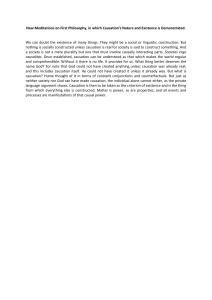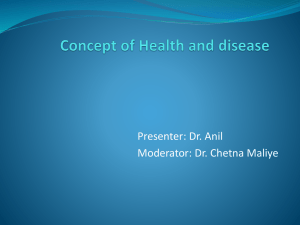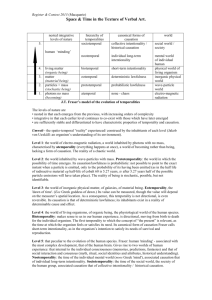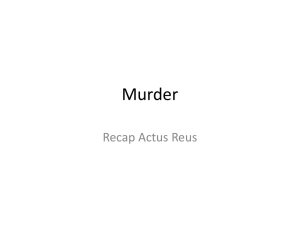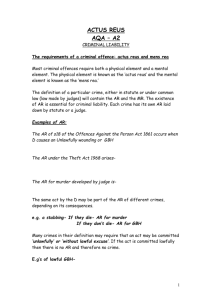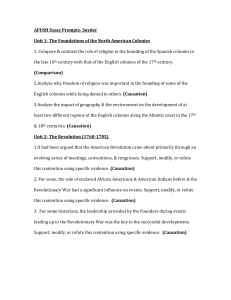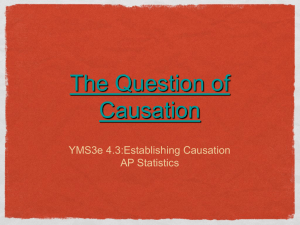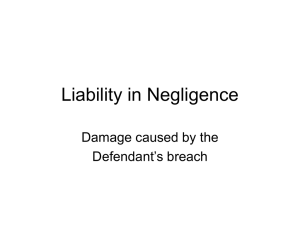Causation
advertisement
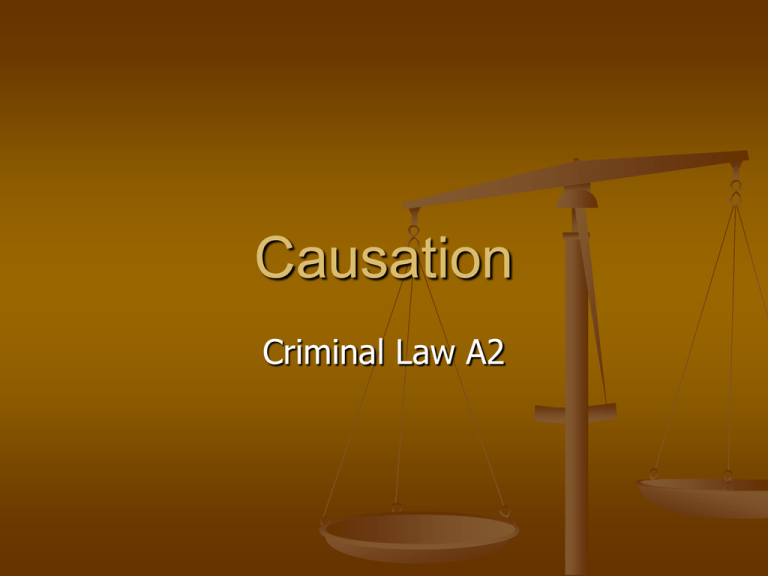
Causation Criminal Law A2 Where a consequence must be proved, prosecution must show that the defendants conduct was :1. the factual cause of that consequence and 2. the legal cause of that consequence and 3. there was no intervening act which broke the chain of causation Factual Cause- But For Only guilty if consequence would not have happened but for the D act or conduct Pagett 1983 White 1910 Legal Cause There may be more than one act, some carried out by other people D can still be guilty if his conduct was more than the minimal cause of consequence but need not be substantial Kimsey 1996 –slight or trifling Intervening Acts Must be a direct link from D conduct to the consequence. This is known as the Chain of Causation Sometimes something happens after the defendants act or omission and if this is sufficiently separate from the D conduct it may break chain of causation. Chain of Causation can be broken by An act of a third party Victims own act or a natural but unpredictable event D will then not be responsible. The intervening act must be sufficient independent of defendant act and sufficient independent of defendants conduct and sufficient serious Where D act causes a foreseeable action by a third party then D likely to have caused the consequence (Pagett 1983) Medical Attention Medical attention is unlikely to break the Chain of Causation- (Duty to Act Bland) Unless so far removed from the original act Smith 1959 Cheshire 1991 Jordan 1956 Switching of a life support machine ( by a Dr) does not break the chain of causation Malcherek 1981 Victims Own Act If D causes V to react in a foreseeable way, then any injury to the V will be considered to have been caused by the D Roberts 1971 Marjoram 2000 If however the V reaction is unreasonable then this may break the Chain of Causation Williams 1992 Thin Skull Rule The defendant must take the victim as he finds him. In other words if V has something unusual about him which makes the injury more serious then the D is liable for the more serious injury. Blaue 1975 Problems in the Law of Causation Main problem with the law is what is meant by more than a slight or trifling link Vague can lead to different juries applying different standards Cases - Pagett 1983 The D took his pregnant girlfriend from her home by force. He then held the girl hostage. Police called on him to surrender. D came out holding the girl in front of him and firing at police. The Police returned fire and the girl was killed by police bullets. D was convicted of manslaughter. Cases-Kimsey 1996 D was involved in a high speed car chase with a friend. She lost control of her car and the other driver was killed in the crash. The evidence about what happened immediately before D lost control was not very clear. The trial Judge directed the jury that D’s driving did not have to be the principal or a substantial cause of the death, as long as you are sure that it was a cause and that there was something more than a slight or trifling link. The Court of Appeal upheld D’s conviction for causing death by reckless driving Cases Blaue 1975 A young woman was stabbed by the defendant. She was told that she needed a blood transfusion to save her life but she refused to have one as she was a Jehovah’s witness and her religion forbade blood transfusions. She died and the D was convicted of her murder. The fact that the victim was a Jehovah Witness made the wound fatal, but the D was still guilty because he had to take his victim as he found them take his victim as he found them Cases Smith 1959 Two soldiers had a fight and one was stabbed in the lung by the other. The victim was carried to a medical centre by other soldiers, but was dropped on the way. At the medical centre the staff gave him artificial respiration by pressing on his chest. This made the injury worse and he died. The poor treatment probably affected his chances of recovery by as much as 75%. However the original attacker was still guilty of his murder. In this case it was held that a D would be guilty, provided that the injury caused by D was still an operating and substantial cause of death. Smith was guilty because the stab wound to the lung was still operating (it obviously had not healed up) and it was a substantial cause of V’s death. Cases- Cheshire 1991 D shot V in the thigh and stomach. V needed major surgery. He developed breathing problems and was given a tracheotomy (i.e. a tube was inserted in his throat to help him breath). Some two months after the shooting, V died from rare complications left by the tracheotomy. These complications were not diagnosed by the Dr’s. By the time V died the original wounds had virtually healed and were no longer life threatening. The D was still held liable for V’s death. In this case the Court of Appeal held that even though treatment for injuries was short of the standard expected of a competent medical practioner, D could still be criminally responsible for the death. The prosecution had only to prove that D’s acts contributed to the death. D’s act need not be the sole cause or main cause of death, provided that his acts contributed significantly to the death. Cases-Jordan 1956 The V had been stabbed in the stomach. He was treated in hospital and the wounds were healing well. He was given an antibiotic but suffered an allergic reaction to it. One Dr stopped use of the antibiotic but the next day another Dr ordered that a large dose of it be given. The V died from the allergic reaction to the drug. In this case the actions of the Dr were held to be an intervening act which caused the death. The D was not guilty of murder. Cases- Malcherek 1981 D stabbed his wife in the stomach. At hospital she was put on a life support machine. After a number of tests showed that she was brain dead, the machine was switched off. D was charged with her murder. The trial judge refused to allow the issue of causation to go to the jury. D was convicted and the court of appeal up held his conviction Cases- Roberts 1971 A girl jumped from a car in order to escape from Roberts’ sexual advances. The car was travelling at 20 and 40 MPH and the girl was injured through jumping from it. The D was held to be liable for her injuries Cases - Williams 1992 A hitch hiker jumped from Williams car and died from head injuries caused by his head hitting the road. The car was travelling about 30 mph. The prosecution alleged that there had been an attempt to steal the V wallet and that was the reason for his jumping. The C of A said the victims act had to be foreseeable and proportionate to the threat. Qu to answer was V conduct within the ambit of reasonableness and not so daft as to make his own voluntary act one which amounted to a novus actus intervention and consequently broke the chain of causation Cases - Marjoram 2000 Several people including \d shouted abuse and kicked the door of V’s hostel room. They eventually forced the door open, V then fell (or possibly jumped) from the window of the room and suffered serious injuries. D’s conviction for inflicting grievous bodily harm was upheld by the court of appeal. In this situation it was foreseeable that V would fear that the group were going to use violence against him and that the only escape route for him was the window. Questions In Malcherek 1981 why do you think the judge refused to let the jury consider causation? Why was the Dr’s actions in Jordan 1956 considered to be an intervening act? Why was the D still responsible for V’s death in Blaue 1975 when it could have been saved with a blood transfusion? Why was D responsible for the V death in Roberts 1971 but not in Williams 1992? Task Create a table to show the key facts on Causation and Medical Intervention. Quality Criteria Key facts on causation Cases Law Task Write a paragraph or two to summarise the facts of causation and medical intervention Refer to relevant cases to back up your points Make a list of the cases relevant to Causation Law and write key words to help you remember the facts of the case Task Choose one of the following cases and create a poster to explain to the rest of the class the key events of the case and the important point of case law. Jordan 1956 Smith 1959 Roberts 1971 Malcherek 1981 Cheshire 1991 Williams 1992 Marjoram 2000
